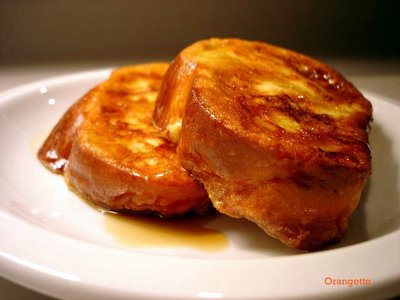For a French-toast master on his 76th
My father loved to play in the kitchen. For him, relaxing after a long day of patients and paperwork meant pouring a Scotch and taking up residence at the butcher-block island. Sometimes Burg would scour our overflowing shelves of cookbooks for ideas or techniques, but mainly he’d work by feel and taste, stewing, sautéing, melding this and that—and never keeping the slightest note of the path that led him from start to finished dish. Somewhere there may be an index card in his blocky handwriting, detailing the ingredients for his trademark vinaigrette or summertime potato salad, but it’s unlikely and, anyway, hidden forever in the dark recesses of an overfilled kitchen drawer. His experiments were many, and most were fruitful, but his was an uncalculating science: personal, sensual, ephemeral.
What I remember most clearly aren’t his lamb shanks or inventions involving endive; it’s Saturday breakfast. Burg, never a late sleeper, would rise early to prowl the local garage-sale scene—occasionally even scrounging up a dubious treasure, such as an ancient, leaden Sharp “Half Pint” microwave, which I promptly dubbed the “Half Ton”—but he came home in mid-morning to refuel, and to make breakfast for me. It was nothing fancy—I grew up on Bisquick pancakes and honestly, it’s hard to find a better batter today—but we did have standards. From an early age, I was trained to be a 100%-pure-maple syrup snob. As a native Canadian, Burg would have nothing else. He bought his chosen brand in an appealingly round-bellied plastic jug and stashed it in the door of the fridge, where it would beckon insistently until Saturday would roll around.
While I was very fond of the pancakes—fluffy and perfectly circular, thanks to our trusty pancake pan—it is Burg’s French toast that haunts me. He was a strong proponent of cooking French toast in oil rather than butter, and in fact, one of my most vivid memories of the last weeks of his life is a bedside conversation I had with him and my half-sister Lisa in the hospital, discussing the merits of oil versus butter in French-toast cookery. The hot oil, Burg claimed, seals the outside of the bread and turns it wondrously crisp and lightly puffed, while the inside melts to a near-custard. He was clearly onto something, because I’ve never had a better version than his. I’m not sure that I can equal it, but this morning, with the help of a loaf of challah I rescued from the freezer, I’ve come close.
Today would be Burg’s 76th birthday, and it seems only fitting to celebrate him this way. For one of the first times in weeks, the sun is shining—a little tentatively, but shining nonetheless. This morning reminds me of a poem I found in one of Burg’s bathroom drawers in the days after his death. It was written on the back of an index card—I suppose he did write some things down—and it must have been the fruit of a mid-meeting brainstorm, or maybe an early-morning revelation between garage sales. I don’t think he’d mind my sharing it, but if he does, well, I trust he’ll find some tricky, playful way to let me know. Or then again, since I’ve said awfully nice things about his cooking, maybe he’ll let me enjoy my French toast in peace.
Sunrise (A Too-Long Haiku)
The sun bursts
Out of the eastern night
And flames the sky
With joy—
Your smile.
*****
(My Attempt at) Burg’s French Toast
1 cup milk (I used whole, but he probably used 2%)
4 large eggs
1 Tbs sugar
1 tsp pure vanilla extract
¼ tsp salt
Mild-tasting vegetable oil, such as canola
6 slices bread (a bias-cut country French loaf, or challah, preferably), about ¾ to 1 inch thick
Pure maple syrup, for serving
Whisk together the first five ingredients in a wide, shallow bowl.
Place a large skillet, preferably cast-iron, over low to medium heat, and add enough oil to just cover the bottom of the skillet.
Two or three at a time, add the bread slices to the egg mixture in the bowl, allowing them to rest for a minute or two on each side. They should feel heavy and thoroughly saturated, but they should not be falling apart. When the oil is hot, place the slices in the skillet. They should sizzle a bit, and the oil should bubble lightly around the edges of the bread; take care, however, that the oil is not too hot, lest the egg mixture burn. Cook until the underside of each slice is golden brown, about 2 minutes. Turn the bread, and cook until the second side is golden, another 2 minutes or so. Remove the bread from the skillet to a plate lined with a paper towel, allow to rest for 30 seconds or so, and serve immediately—with maple syrup, of course.
Yield: 6 slices, serving 2 or 3.


